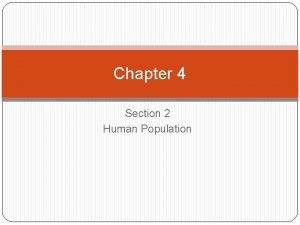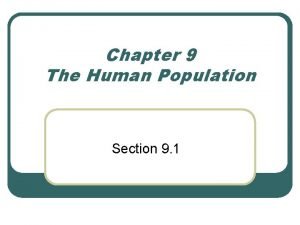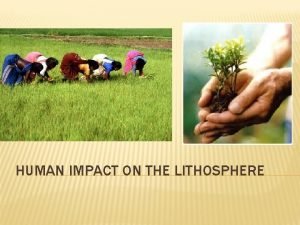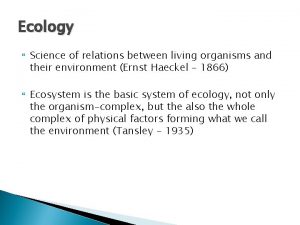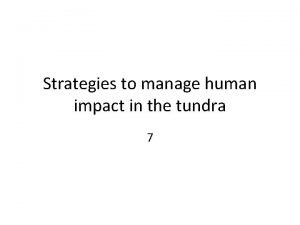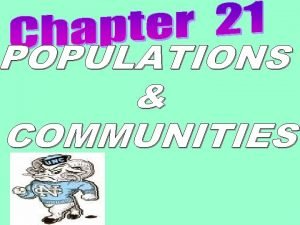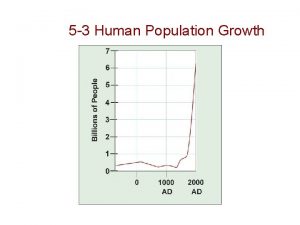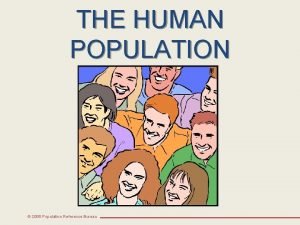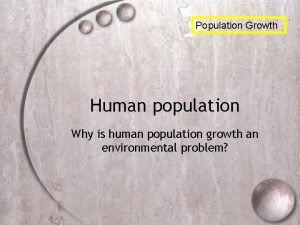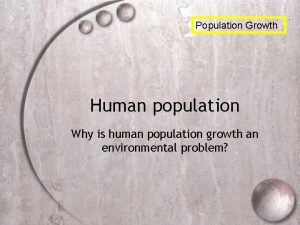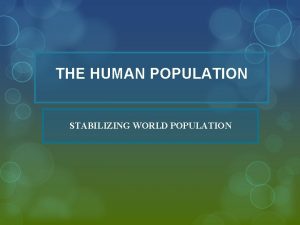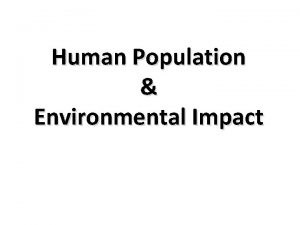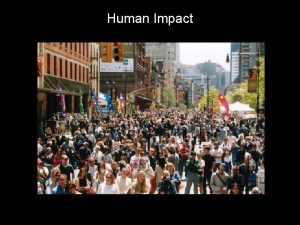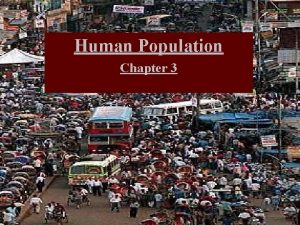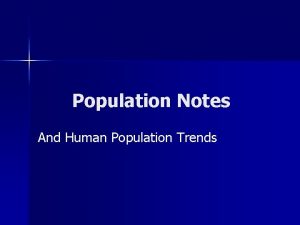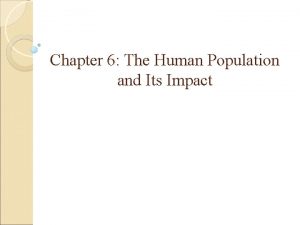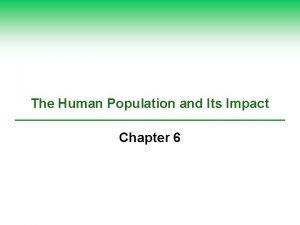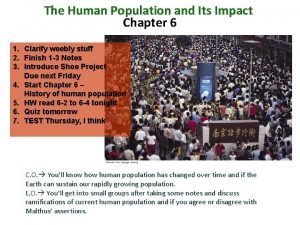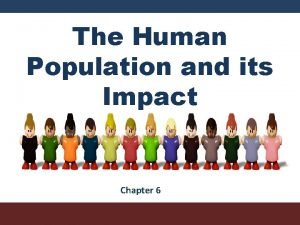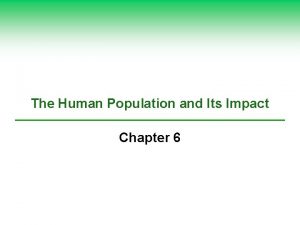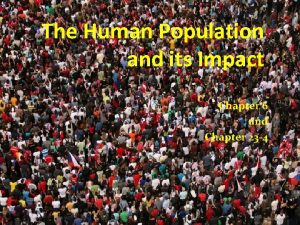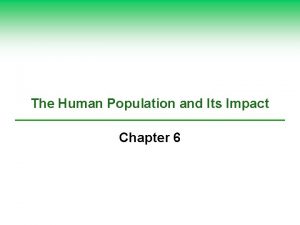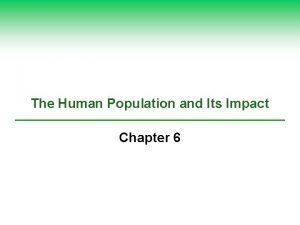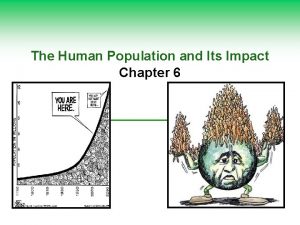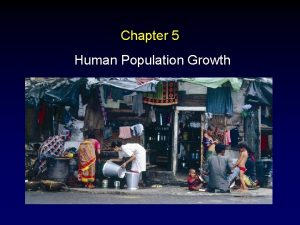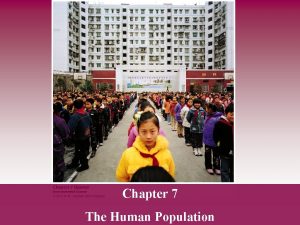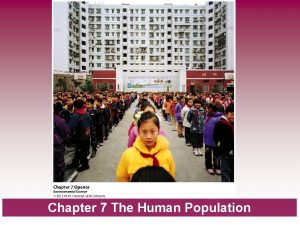The Human Population and Its Impact Chapter 6
































- Slides: 32

The Human Population and Its Impact Chapter 6 Dr. Wesam Al Madhoun

Core Case Study: Are There Too Many of Us? (1) § Estimated 2. 4 billion more people by 2050 § Are there too many people already? § Will technological advances overcome environmental resistance that populations face? § Should populations be controlled?

Core Case Study: Are There Too Many of Us? (2) § Will growing populations cause increased environmental stresses? • • • Infectious diseases Biodiversity losses Water shortages Traffic congestion Pollution of the seas Climate change

Crowded Street in China

6 -1 How Many People Can the Earth Support? § Concept 6 -1 We do not know how long we can continue increasing the earth’s carrying capacity for humans without seriously degrading the lifesupport system for humans and many other species.

Human Population Growth Continues but It Is Unevenly Distributed (1) § Reasons for human population increase • Movement into new habitats and climate zones • Early and modern agriculture methods • Control of infectious diseases through • Sanitation systems • Antibiotics • Vaccines

Human Population Growth Continues but It Is Unevenly Distributed (2) § Population growth in developing countries is increasing 15 times faster than developed countries § By 2050, 97% of growth will be in developing countries § Should the optimum sustainable population be based on cultural carrying capacity?

Global Connections: UN World Population Projections by 2050

NATURAL CAPITAL DEGRADATION Altering Nature to Meet Our Needs Reduction of biodiversity Increasing use of the earth's net primary productivity Increasing genetic resistance of pest species and disease-causing bacteria Elimination of many natural predators Introduction of potentially harmful species into communities Using some renewable resources faster than they can be replenished Interfering with the earth's chemical cycling and energy flow processes Relying mostly on polluting and climatechanging fossil fuels Fig. 6 -A, p. 124

6 -2 What Factors Influence the Size of the Human Population? § Concept 6 -2 A Population size increases because of births and immigration and decreases through deaths and emigration. § Concept 6 -2 B The average number of children born to women in a population (total fertility rate) is the key factor that determines population size.

The Human Population Can Grow, Decline, or Remain Fairly Stable § Population change • Births: fertility • Deaths: mortality • Migration § Population change = (births + immigration) – (deaths + emigration)

1. 3 billion 1. 5 billion China 1. 1 billion 1. 4 billion India USA Indonesia 304 million 357 million 240 million 292 million Pakistan 173 million 229 million Brazil 195 million 229 million Nigeria 148 million 205 million Bangladesh 147 million 180 million Russia 142 million 129 million Japan 128 million 119 million 2008 2025 Fig. 6 -3, p. 126

TFR Rates for the U. S. between 1917 and 2008

Case Study: The U. S. Population Is Growing Rapidly § Drop in TFR in U. S. • Rate of population growth has slowed § Population still growing and not leveling off • Fourfold increase since 1900 § Changes in lifestyle in the U. S. during the 20 th century

47 years Life expectancy 77 years Married women working outside the home 8% 81% 15% High school graduates 83% 10% Homes with flush toilets Homes with electricity Living in suburbs Hourly manufacturing job wage (adjusted for inflation) Homicides per 100, 000 people 98% 2% 99% 10% 52% $3 1900 2000 $15 1. 2 5. 8 Fig. 6 -6, p. 128

Several Factors Affect Birth Rates and Fertility Rates (1) § Children as part of the labor force § Cost of raising and educating children § Availability of private and public pension § Urbanization § Educational and employment opportunities for women

Several Factors Affect Birth Rates and Fertility Rates (2) § Infant mortality rate § Average of a woman at birth of first child § Availability of legal abortions § Availability of reliable birth control methods § Religious beliefs, traditions, and cultural norms

Several Factors Affect Death Rates (1) § Life expectancy § Infant mortality rate § Why are people living longer and fewer infants dying? • • Increased food supply and distribution Better nutrition Medical advances Improved sanitation

Several Factors Affect Death Rates (2) § U. S. infant mortality rate high due to • Inadequate health care for poor women during pregnancy and their infants • Drug addiction among pregnant women • High birth rate among teenagers

Migration Affects an Area’s Population Size § Economic improvement § Religious freedom § Political freedom § Wars § Environmental refugees

6 -3 How Does a Population’s Age Structure Affect Its Growth or Decline? § Concept 6 -3 The numbers of males and females in young, middle, and older age groups determine how fast a population grows or declines.

Populations Made Up Mostly of Young People Can Grow Rapidly § Age structure categories • Prereproductive ages • Reproductive ages • Postreproductive ages

Male Female Expanding Rapidly Guatemala Nigeria Saudi Arabia Prereproductive ages 0– 14 Male Female Expanding Slowly United States Australia China Reproductive ages 15– 44 Male Female Stable Japan Italy Greece Male Postreproductive ages 45– 85+ Female Declining Germany Bulgaria Russia Fig. 6 -8, p. 131

Tracking the Baby-Boom Generation in the United States

Populations Can Decline from a Rising Death Rate: The AIDS Tragedy § 25 million killed by 2008 § Many young adults die: loss of most productive workers § Sharp drop in life expectancy § International community called upon to • Reduce the spread of HIV through education and health care • Financial assistance and volunteers

6 -4 How Can We Slow Human Population Growth? § Concept 6 -4 Experience indicates that the most effective ways to slow human population growth are to encourage family planning, to reduce poverty, and to elevate the status of women.

As Countries Develop, Their Populations Tend to Grow More Slowly § Demographic transition stages • Preindustrial • Transitional • May lead to a demographic trap • Industrial • Postindustrial

Birth rate and death rate (number per 1, 000 per year) Stage 1 Preindustrial Population grows very slowly because of a high birth rate (to compensate for high infant 80 mortality) and a 70 high death rate 60 Stage 3 Industrial Stage 2 Transitional Population grows rapidly because birth rates are high and death rates drop because of improved food production and health Stage 4 Postindustrial Population growth slows as both birth and death rates drop because of improved food production, health, and education Population growth levels off and then declines as birth rates equal and then fall below death rates Total population Birth rate 50 40 30 Death rate 20 10 0 Low Increasing Very high Decreasing Growth rate over time Low Zero Negative Stepped Art Fig. 6 -12, p. 134

Planning for Babies Works § Family Planning • Responsible for a 55% drop in TFRs • In developing countries • Expansion of program • Include teenagers, sexually active unmarried women, and men § Slow and stabilize population growth • Invest in family planning • Reduce poverty • Elevate the social and economic status of women

Empowering Women Can Slow Population Growth § Education § Paying jobs § Human rights without suppression § “For poor women the only holiday is when you are asleep”

Women from a Village in Burkina Faso Returning with Fuelwood

Case Study: Slowing Population Growth in China: the One-Child Policy § Encourages fewer children § Gender imbalance § Fast-growing economy § Face serious resource and environmental problems
 Chapter 4 section 1 population dynamics answer key
Chapter 4 section 1 population dynamics answer key Section 1 population dynamics answer key
Section 1 population dynamics answer key Chapter 27 human impact on earth resources
Chapter 27 human impact on earth resources Chapter 16: human impact on ecosystems answer key
Chapter 16: human impact on ecosystems answer key Chapter 16 human impact on ecosystems
Chapter 16 human impact on ecosystems Renaissance means
Renaissance means Lesson 5 the slave trade and its impact on africa
Lesson 5 the slave trade and its impact on africa Chapter 4 section 2 human population answer key
Chapter 4 section 2 human population answer key Chapter 4 population ecology answer key
Chapter 4 population ecology answer key Chapter 9 the human population section 1
Chapter 9 the human population section 1 Population ecology section 1 population dynamics
Population ecology section 1 population dynamics Population ecology section 1 population dynamics
Population ecology section 1 population dynamics Chapter 8 human needs and human development
Chapter 8 human needs and human development Chapter 8 human needs and human development
Chapter 8 human needs and human development Form of emigree
Form of emigree Its halloween its halloween the moon is full and bright
Its halloween its halloween the moon is full and bright Human movement science impact factor
Human movement science impact factor Chile biomes
Chile biomes Human impact on the lithosphere
Human impact on the lithosphere Human impact on agriculture
Human impact on agriculture Carbon cycle human impact
Carbon cycle human impact Human impact on terrestrial ecosystems
Human impact on terrestrial ecosystems Cold desert biome map
Cold desert biome map Human impact in the tundra
Human impact in the tundra Human impact on beaches
Human impact on beaches Human impact on groundwater
Human impact on groundwater Lentic ecosystem
Lentic ecosystem Human impact on oceans
Human impact on oceans What is an energy role
What is an energy role Section 5-3 human population growth
Section 5-3 human population growth Slow growth age structure diagram
Slow growth age structure diagram Human population
Human population Famous human design reflectors
Famous human design reflectors







